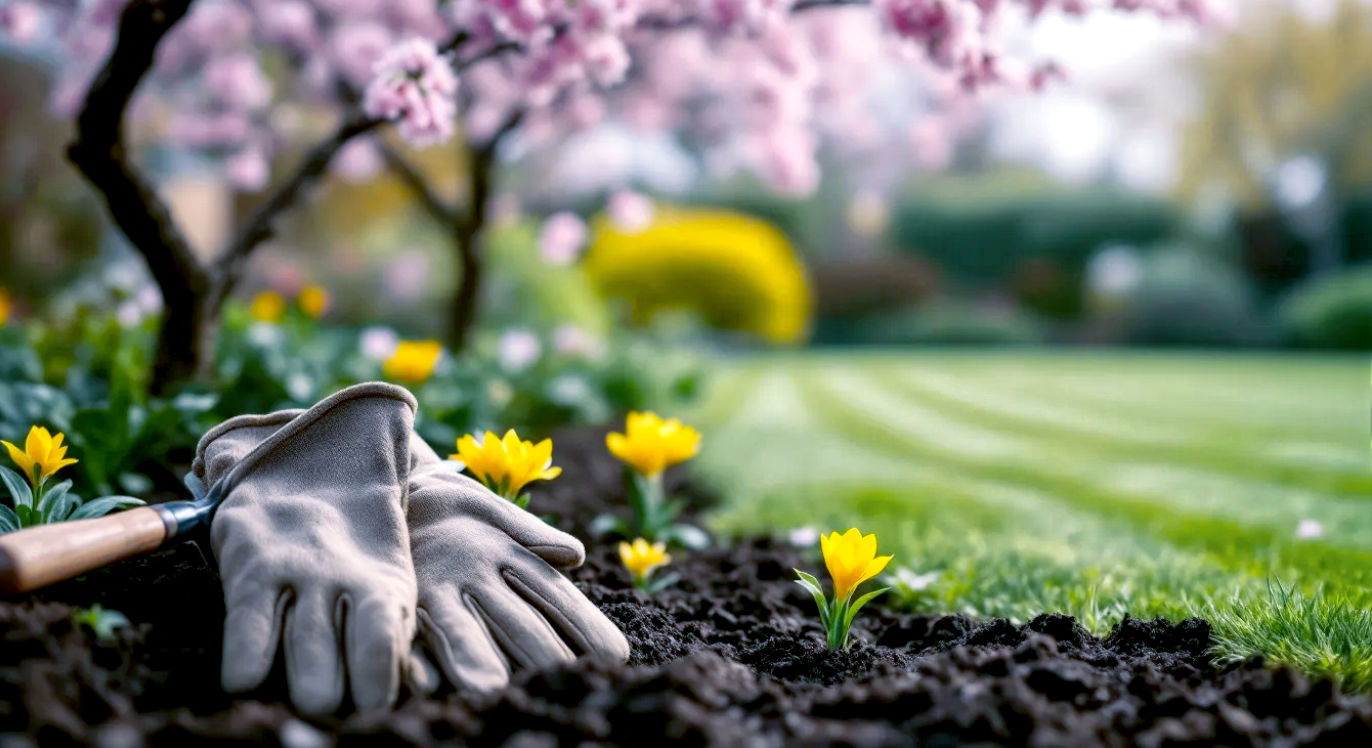Spring Awakening: The Guide to Kickstarting Your Garden as Temperatures Thaw
Ready to get your garden blooming? Our definitive guide covers everything you need for spring in the UK, from the big tidy-up to planting your first seeds.

This post may contain affiliate links. If you make a purchase through these links, we may earn a commission at no additional cost to you.
There’s a special kind of magic in the British air when winter finally decides to pack its bags. You can feel it on the slightly less biting wind, see it in the lighter evenings, and hear it in the tentative birdsong at dawn. For anyone with a patch of earth to call their own—be it a sprawling country lawn, a neat suburban plot, or a few pots on a city balcony—this is the starting gun. This is the moment we’ve been waiting for through all the grey, drizzly months. It’s time to get our hands dirty.
Spring gardening in the UK isn’t just a hobby; it’s a national obsession, a hopeful ritual passed down through generations. It’s about coaxing life from the sleepy soil and creating a small patch of beauty that’s uniquely yours. But it can also feel a bit daunting. When exactly do you start? What needs doing first? And how do you avoid the classic British pitfall of a late frost wiping out all your hard work?
Don’t you worry. Think of this guide as a friendly chat over the garden fence with a neighbour who’s seen it all before. We’ll walk you through everything, step-by-step, from waking up your soil to that glorious first bloom or harvest. Whether you’re dreaming of a riot of colourful flowers, a bounty of homegrown veg, or just a tidy, green space to enjoy a cuppa in the sun, this is your starting point. Let’s dig in.
The Grand Spring Tidy-Up: Your First Port of Call
Before you can plant anything new, you need to deal with the aftermath of winter. It’s not the most glamorous job, but it’s absolutely essential. Think of it as spring cleaning, but for the great outdoors.
Clearing the Decks: Weeds, Leaves, and Debris
Winter has a habit of leaving a mess. Fallen leaves, twigs, and other bits and bobs will have gathered in corners and on your lawn. More importantly, some very stubborn weeds will have been quietly biding their time, ready to explode into life as soon as it warms up.
- Why it matters: Clearing this debris does more than just make the garden look neat. A thick blanket of wet leaves can suffocate your lawn and the delicate new shoots trying to poke through your flower beds. It also provides a five-star hotel for slugs, snails, and other pests you’d rather not encourage.
- Get stuck in: Grab a rake and your garden gloves. Clear all the leaves and debris from your lawns, beds, and paths. This is also the perfect time to tackle those early weeds. Get them now while they’re small and their roots are weak. Pesky perennial weeds like dandelions, couch grass, and bindweed are much easier to pull out of damp, soft spring soil. For really stubborn ones, a hand fork is your best friend.
- A note on composting: Don’t just bin all that garden waste! Healthy leaves and soft plant debris can go straight onto your compost heap. Avoid adding diseased plants or tough, woody stems, as they can cause problems later. Weeds that have started to set seed should also be left out, unless you want a compost bin full of baby weeds.
Pruning and Cutting Back: The Kindest Cut
Many plants benefit from a good trim in late winter or early spring. This encourages strong new growth, helps create a better shape, and can lead to more flowers and fruit later in the year. But it’s crucial to know what to prune and when.
- What to prune now:
- Summer-flowering shrubs: Plants like Buddleia (the butterfly bush), late-flowering Clematis (the ones that flower on new growth), and hardy Fuchsias should be cut back hard now. This feels brutal, but it encourages them to produce lots of fresh stems, which are what will carry this summer’s flowers.
- Roses: Bush and climbing roses need a good prune in late winter or early spring to keep them healthy and flowering well. The general idea is to remove any dead, diseased, or crossing branches to open up the centre of the plant.
- Wisteria: For a spectacular floral display, Wisteria needs to be pruned twice a year. The spring prune, usually in February, involves cutting back the side shoots you trimmed last summer to just two or three buds.
- What NOT to prune now: Be careful with spring-flowering shrubs like Forsythia and Philadelphus (mock orange). If you prune them now, you’ll cut off all the flower buds for this year! These should be pruned after they’ve finished flowering.
Preparing the Groundwork: The Secret to a Sensational Garden
A great garden starts with great soil. It’s the foundation of everything. Spring is the perfect time to give your soil a bit of love and get it ready for planting.
Waking Up Your Soil
After a long, wet winter, soil can become heavy and compacted. This makes it hard for plant roots to grow and for water to drain away properly. Your job is to gently wake it up and get it breathing again.
- When to start: The golden rule is to wait until the soil is workable. Don’t be tempted to dig when the ground is frozen solid or when it’s a soggy, muddy mess. Working wet soil can wreck its structure for the rest of the year. How can you tell? Grab a handful of soil and squeeze it. If it forms a solid, slimy ball, it’s too wet. If it crumbles apart gently, you’re good to go. This usually happens around March in the south of the UK, and a little later in the north and Scotland.
- How to do it: Use a garden fork to gently turn over the soil in your beds. You don’t need to dig down to Australia. Just aim to loosen the top 6-8 inches. This breaks up compacted clumps, improves drainage, and allows air to get to the roots of your future plants. As you go, remove any large stones or leftover weed roots you find.
Feeding the Earth: The Importance of Mulching
Once you’ve loosened the soil, it’s time to give it a good feed. The best way to do this is by adding a thick layer of organic matter, a process known as mulching.
- What is organic matter? This is just a fancy term for well-rotted, natural material. Think garden compost, well-rotted manure, leaf mould, or even soil conditioners you can buy in bags from the garden centre.
- Why is it so good? Adding this stuff to your soil is like giving your garden a superfood smoothie. It does several amazing things:
- Improves structure: On heavy clay soil, it helps break up the clumps and improve drainage. On sandy soil, it helps hold onto water and nutrients. It’s a win-win.
- Adds nutrients: It provides a slow, steady supply of food for your plants throughout the year.
- Suppresses weeds: A thick layer of mulch on the surface makes it harder for weed seeds to germinate.
- How to apply it: Simply spread a generous layer, about 2-3 inches thick, over the surface of your soil. You can gently fork it into the top few inches or just leave it on the surface. The worms will do the hard work of pulling it down into the soil for you!
Planning Your Green Kingdom: What to Grow and Where
With the prep work done, now comes the exciting bit: deciding what you’re going to grow this year. A little bit of planning now will pay off handsomely later.
Know Your Plot: Sun, Shade, and Soil
Before you rush off to the garden centre, take a moment to really look at your garden. Different plants have different needs, and the key to success is putting the right plant in the right place.
- Track the sun: Spend a day noticing which parts of your garden get sun and for how long.
- Full sun: Gets at least 6 hours of direct sun a day. Perfect for things like tomatoes, roses, and lavender.
- Partial shade: Gets 3-6 hours of sun. Good for many flowers and vegetables like lettuces and raspberries.
- Full shade: Gets less than 3 hours of direct sun. Don’t despair! This is ideal for beautiful plants like ferns, hostas, and foxgloves.
- Understand your soil type: We’ve already talked about improving your soil, but it helps to know what you’re starting with. Is it heavy clay that’s sticky when wet? Or is it light and sandy, draining really quickly? Most British gardens fall somewhere in between, but knowing your type helps you choose plants that will naturally be happy there.
- Factor in the wind: Is your garden a sheltered sun trap or an exposed, windy spot? Wind can be very damaging to delicate plants. If you’re in a windy location, consider planting a hedge or putting up a trellis to act as a windbreak.
What to Plant in Spring: A Season of Possibilities
Spring is a busy planting season. You can sow seeds, plant young plants, and put in shrubs and trees. Here’s a breakdown of what you can get cracking on with.
The Vegetable Patch Revival
Growing your own food is one of the most rewarding things you can do. Even a few pots can give you a delicious harvest.
- Hardy vegetables (can be sown directly outside from March/April):
- Peas and Broad Beans: These are classic early spring crops. They don’t mind a bit of cold.
- Salad Leaves: Things like lettuce, spinach, and rocket can be sown in succession for a continuous supply.
- Radishes: The ultimate beginner’s veg. They grow incredibly quickly!
- Root Veg: Carrots, parsnips, and beetroot can be sown directly into well-prepared soil.
- Tender vegetables (start indoors now, plant out later):
- Tomatoes, Peppers, and Chillies: These sun-lovers need a long growing season. Sow them indoors now on a sunny windowsill or in a greenhouse to give them a head start. They can’t go outside until all risk of frost has passed (usually late May or early June).
- Courgettes, Pumpkins, and Squashes: Similar to tomatoes, these need to be started indoors.
- Seed Potatoes: ‘Chitting’ your potatoes is a great little spring ritual. This just means letting them sprout before you plant them. Stand them on end in an egg box on a cool, bright windowsill. Once the sprouts are about an inch long, they’re ready to be planted out, usually in March or April.
A Symphony of Flowers
Spring is the time to plan for a summer filled with colour and scent.
- Hardy Annuals (can be sown directly outside from April): These are flowers that complete their whole life cycle in one year. They are cheap, easy, and brilliant for filling gaps. Think of cottage garden favourites like Nigella (love-in-a-mist), Calendula (pot marigolds), and Poppies. Simply scatter the seeds over prepared soil, rake them in gently, and water.
- Half-Hardy Annuals (start indoors now): These are the stars of British summer bedding displays. Plants like Petunias, Marigolds, and Cosmos can’t handle frost, so sow them indoors now in pots or seed trays. They can be planted out in late May.
- Summer-Flowering Bulbs: It’s not too late for bulbs! Plant summer-flowering bulbs like Lilies, Gladioli, and Dahlias in spring for a spectacular show later in the year. Dahlias, in particular, are fantastic value, producing masses of flowers right through until the first frosts of autumn.
- Perennials: These are plants that come back year after year. Spring is an excellent time to plant new perennials or to divide existing clumps that have got too big. Dividing plants like Hostas, Hemerocallis (daylilies), and hardy Geraniums is a great way to get free plants and keep the originals healthy.
Caring for Your Lawn: The Great British Carpet
A lush, green lawn is the pride of many a British garden. Spring is the time to give it some TLC after the rigours of winter.
First Steps to a Perfect Lawn
Don’t be tempted to go in too hard, too early. Your lawn is still waking up.
- Raking (Scarifying): Your first job is to give the lawn a vigorous rake with a spring-tined rake. This does two things: it removes the layer of dead grass and moss at the base of the turf (known as thatch), and it pulls up moss. This allows air and light to get to the grass roots.
- Aerating: If your lawn gets a lot of foot traffic or is on heavy soil, it can become compacted. Aerating simply means making small holes in the lawn to relieve this compaction. For a small lawn, you can do this by simply pushing a garden fork into the ground every 6 inches or so. For larger areas, you can hire a machine.
- The First Cut: Wait for a dry day when the grass has started to grow noticeably. For the first cut of the year, set your mower blades high. You just want to trim the very tips of the grass. Cutting it too short, too early can shock the lawn and encourage weeds and moss.
Feeding and Weeding
A hungry lawn is a sad lawn. A spring feed will give it the energy it needs to grow thick and green.
- Spring Lawn Feed: Use a specific spring/summer lawn fertiliser. These are high in nitrogen, which is the nutrient that promotes leafy green growth. You can get granular feeds that you scatter over the surface or liquid feeds that you apply with a watering can. Always follow the packet instructions carefully—too much can scorch the grass.
- Dealing with Weeds and Moss: If your lawn has a lot of moss or weeds, you can use an all-in-one ‘feed, weed, and moss killer’ product. The moss will turn black and can then be raked out a couple of weeks later.
- Repairing Patches: Winter can leave bare patches in your lawn. Spring is the ideal time to fix them. Loosen the soil in the patch with a fork, sprinkle on some grass seed mixed with a little compost, and water it in gently. Keep it watered until the new grass is established.
Special Projects: Containers, Climbers, and Ponds
Spring is a great time to tackle those little projects that can make a big difference to your garden.
Container Gardening: Perfect for Patios and Balconies
You don’t need a huge garden to enjoy growing things. Pots, tubs, and hanging baskets can provide a fantastic splash of colour.
- A Fresh Start: Empty out your old pots and give them a good scrub to remove any old soil and potential pests or diseases.
- Use Fresh Compost: Don’t reuse last year’s compost. It will be drained of nutrients. Use a good quality, peat-free multi-purpose compost, or a specific container compost which often has water-retaining gels and slow-release fertiliser mixed in.
- Planting Up: You can create beautiful displays by planting a mixture of things. A classic recipe is to have a tall plant in the middle (the ‘thriller’), some bushy plants around it (the ‘fillers’), and some trailing plants to spill over the edge (the ‘spillers’).
- Spring Bedding: For instant colour, pop down to the garden centre and pick up some spring bedding plants like primroses, pansies, and bellis daisies. They are cheap, cheerful, and will brighten up your pots until it’s warm enough for summer bedding.
Supporting Your Climbers
Climbing plants like roses, clematis, and honeysuckle add a wonderful vertical dimension to a garden. Spring is the time to make sure they have the support they need.
- Check Supports: Check that wires, trellises, and arches are still secure after any winter storms. Make any necessary repairs now before the plants put on lots of new growth.
- Tie in New Shoots: As your climbers start to grow, gently tie the new shoots to their supports. Use soft garden twine to avoid damaging the delicate stems. Tying them in horizontally, rather than letting them go straight up, encourages them to produce more flowers along the length of the stem.
Waking Up the Wildlife Pond
If you’re lucky enough to have a pond, spring is when it will start to burst back into life.
- Gentle Cleaning: Remove any fallen leaves and debris that have accumulated over winter. A child’s fishing net is perfect for this. Try to leave some of the sludge at the bottom, as this is where many creatures hibernate.
- Manage Plants: Cut back any dead or decaying foliage from pond plants. If you have plants like waterlilies, now is a good time to re-pot or divide them if they’ve outgrown their baskets.
- Don’t Disturb the Wildlife: Be gentle! You’ll likely find frogspawn appearing from March onwards. Try not to disturb it. Ponds are a haven for wildlife, and it’s a joy to watch them wake up in spring.
Staying Ahead of Pests and Problems
A healthy garden is the best defence against pests and diseases. But it’s wise to be vigilant in spring.
The Slug and Snail Offensive
As new shoots emerge, they are a Michelin-starred meal for slugs and snails.
- Be a Detective: Go out on a damp evening with a torch. You’ll be amazed (and possibly horrified) at how many you can find and remove by hand.
- Create Barriers: Crushed eggshells, sharp grit, or wool pellets placed around vulnerable plants can create a barrier that’s uncomfortable for them to cross.
- Beer Traps: A simple jam jar sunk into the soil and filled with cheap beer is an old but effective trap.
- Organic Pellets: If you do need to use slug pellets, choose ones that are certified for organic use. These contain ferric phosphate, which is not harmful to pets, birds, and other wildlife.
Keeping an Eye Out for Aphids
Greenfly and blackfly love soft, new growth.
- Check Your Plants: Look on the undersides of leaves and on new shoots.
- Squash or Spray: For a small infestation, you can simply squash them with your fingers. For a larger problem, a spray of soapy water (a few drops of washing-up liquid in a spray bottle of water) can be effective.
- Encourage Ladybirds: Ladybirds are the ultimate aphid-eating machines. You can encourage them by planting things they like, such as marigolds, and by avoiding chemical sprays.
The Final Word: Embrace the Pace of Spring
Perhaps the most important piece of advice for spring gardening in Britain is to be patient and observant. Our weather is famously unpredictable. A warm, sunny week in March can easily be followed by a sharp frost in April.
Don’t be in a mad rush. Watch the weather forecast. Feel the soil. Look for the signs that nature gives you—the unfurling of leaves on the trees, the arrival of the swifts. The garden will tell you when it’s ready.
Spring gardening is a journey, not a race. It’s about the quiet satisfaction of a job well done, the connection with the earth, and the joyful anticipation of the beauty and bounty to come. So, pull on your wellies, grab your trowel, and go and make some spring magic. You’ve got this.
Further Reading
For those eager to dig even deeper, here are some of the most respected resources in British gardening:
- Royal Horticultural Society (RHS): The absolute authority on all things gardening in the UK. Their website is a goldmine of reliable, expert advice. https://www.rhs.org.uk/
- Gardeners’ World: The online home of the beloved BBC programme. It’s packed with practical tips, seasonal advice, and inspiration from the nation’s favourite gardeners. https://www.gardenersworld.com/
- The National Trust: Beyond their beautiful houses, the National Trust manages some of Britain’s most stunning gardens. Their site offers inspiration and insights into traditional British horticulture. https://www.nationaltrust.org.uk/gardens-and-parks
- The Wildlife Trusts: For fantastic advice on how to make your garden a haven for British wildlife, from bees and butterflies to hedgehogs and birds. https://www.wildlifetrusts.org/gardening






